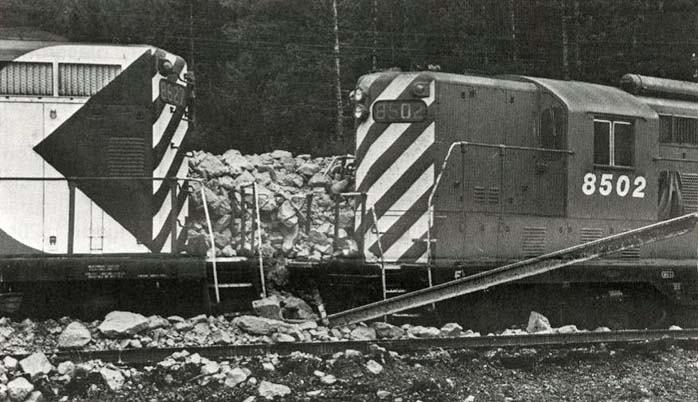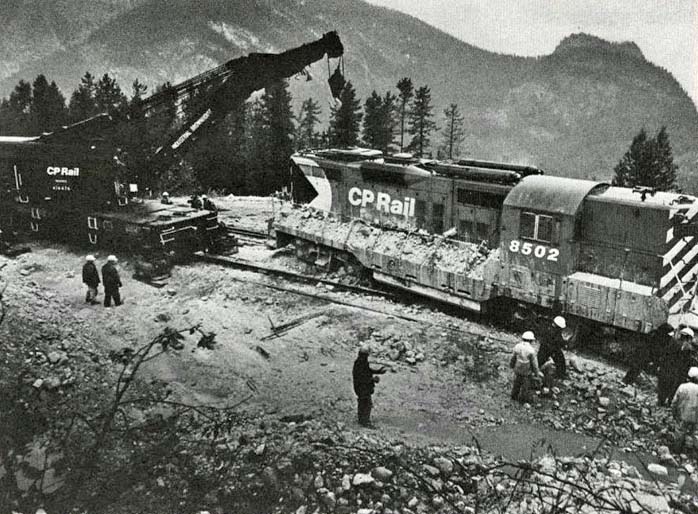
Number 13
October 11, 1978
Delayed by Weather

barrier against slide which rests on opposite side - Nicholas Morant.
Cathedral Mountain - When nature unleashes its awesome powers there is little man can do to prevent the resulting devastation.
On Wednesday, 6 Sep 1978, at about 21:00 hours a massive ice wall at the foot of an immense ice field, about 9,200 feet above sea level, just below the summit of Cathedral Mountain collapsed, freeing millions of gallons of water to plummet to the valley floor below.
Carried by the rushing water came hundreds of thousands of cubic yards of rock and silt. As the water-borne rock and silt crashed downward it swept away everything in its path.
Rumbling down the mountain side the slide crossed the CP Rail mainline three times and the Trans-Canada Highway once. Hitting the tracks first at Partridge siding it gauged out a chasm 40 feet deep and 80 feet wide, leaving only the mainline and siding rails to precariously span the gap.
Further down the mountain, at Yoho Yard, two locomotives of a 30 car extra train were engulfed in the tumbling and flowing slide. The two locomotives and the first three cars of the train were derailed and partially buried. Depth of debris covering the yard for nearly half a mile was 20 feet.
As it crossed the Trans-Canada Highway below Yoho, slide depths measured up to eight feet.
Crossing the tracks for a third and last time at Cathedral the mainline was buried to depths of nearly six feet.
Following first report of the slide, rail officers of the Calgary Division worked throughout the night, first to assess the extent of damage and then to determine a plan of action for the clean-up operation to follow.
An auxiliary train from Alyth Yards at Calgary was dispatched for Stephen Wednesday night with orders to stand-by for the clean-up. Arrangements were also made to have leased heavy-duty earth movers at the scene of the slide by dawn. A second auxiliary train from Field arrived early Friday.
At daybreak Thursday, weather conditions remained poor, the rain continued and water still gushed down the slide path.
It took 45 hours from the time of the slide for a total of nearly 100 men, two auxiliary trains, and 18 earthmovers to clear the tracks, reconstruct the road bed at Partridge siding, and dig out and re-rail the two locomotives and three cars.
Throughout the clean-up operations work was hampered by bad weather, ranging from chilly temperatures and rain during the day to light snow at night.
Helping maintain efficiency during the massive clean-up operation was CP Rail's communications department radio equipment. Throughout the day and night the air was filled with the constant crackle of radio signals. One rail official is reported to have said, "if it weren't for those radios we had on hand we might still be there trying to clear each section, one at a time. Good communication was essential to the operation."
The slide area below the summit of Cathedral Mountain is well known to experienced railroaders. Many have dubbed it the three level slide, because it is uniquely situated in a position where one slide can cover the tracks in three places.

back into position on the rails after the slide rubble had been cleared away - Larry Bennett.

